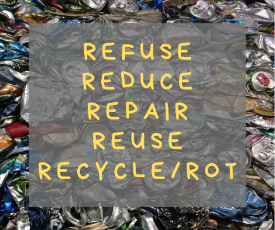 Recycling and composting are great, but the biggest impact you can have on Vermont's waste stream is to create less waste in the first place.
Recycling and composting are great, but the biggest impact you can have on Vermont's waste stream is to create less waste in the first place.
There are countless ways to reduce waste, and many will save you money, especially in the long-term. Start with the ideas that feel right for you and remember that “zero waste” is a goal that starts with creating "less waste." Every product has waste associated with some stage of its life cycle, and some types of waste can’t be avoided. That’s ok. Little changes add up to make a big difference.
 Ideas for reducing waste:
Ideas for reducing waste:
Purchasing:
- Think about whether you can use something you already have and skip the purchase
- Buy second-hand (or swap or borrow instead of buying)
- Buy reusable rather than single-use items
- Shop local to avoid shipping waste
- Select items with minimal packaging
- Select items made from recycled materials (especially post-consumer recycled content)
- Buy in bulk (fill your own containers)
- Select items with packaging made from recycled content
- Select items with recyclable packaging
At Home:
- Continue learning how to shop, store food, and cook so you waste less food and save money
- Repurpose items you already have
- Opt out of junk mail
- Go paperless for bills and bank statements
- Use cloth napkins and rags to reduce paper towel/paper napkin waste
- Follow low-waste cooking strategies (see below for cookbook suggestions)
- Only throw out food when it’s actually bad
- Cook from scratch and eat everything that's edible
- Use reusable food wraps, snack bags, and storage containers
- Make your own household cleaning products and stop using toxic chemicals/cleaners that contribute to household hazardous waste and cost a lot to dispose of
Out and about:
- Bring reusables with you – shopping and produce bags, water bottle, travel mug, container for leftover food, utensils, straw, cloth napkin, etc.
- Refuse:
- Single-use products – shopping bags, extra napkins, straws, utensils, etc.
- Excess packaging and paper receipts
Special Occasions:
- Make gifts – especially upcycling items into something new
- Make cards out of recycled materials
- Wrap gifts creatively; use bags, scarves, towells, fabric, newspaper, used wrapping paper, etc.
- Give experiences like gift certificates to favorite restaurants, parks, entertainment outlets and more instead of things
Parties and Events:
- Go digital for invitations and RSVPs
- Make sure all guests/participants know about zero waste goals
- Use minimal decorations; feature reusable items that you already own; DIY from recycled materials
- Provide clearly-labeled sort stations for compost, recycling, trash, and redeemables (most effective if a volunteer stands by to help)
- Use reusable dishes, utensils, cups, table cloths, and napkins – borrow or rent if you don’t have enough
- If you choose single-use items, try buying products like paper napkins made with recycled content. If we want to make recycling work, we need to buy recycled. If you choose to use compostable products, first consider if your compost facility and food scrap hauler accepts them. If they don't, they will need to be disposed in the trash. If they do, make sure compostable bowls, plates, utensils, etc. are BPI certified compostable.
Need help?
- Ask your waste district or town if they rent out signs, bins, or event kits
- Ask your waste district or town if there is a Waste Warrior volunteer program in your area
Want to learn more? Check out these external resources:
- General Books
- 101 Ways to go Zero Waste, by Kathryn Kellogg
- Less Stuff; Simple Zero-Waste Steps to a Joyful and Clutter-Free Life, by Lindsay Miles
- Life Without Plastic by Chantal Plamondon and Jay Sinha
- The Ultimate 66 day Challenge, by Loulou River
- Zero Waste Home, by Bea Johnson
- Zero Waste: Simple Life Hacks to Drastically Reduce your Trash, by Shia Su
- Cookbooks
